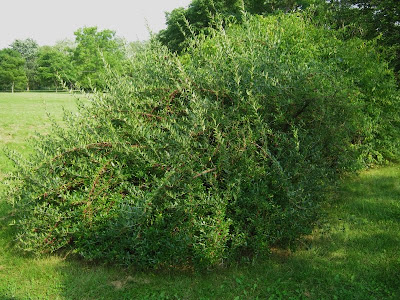They are thorny and arching in habit and have attractive glossy foliage.
All species prefer moist well drained soil in partial to full sun.
Propagated from seed in autumn or softwood cuttings taken in summer.
Prinsepia sinensis ( Cherry Prinsepia )
A rare, moderate growing, long lived, spiny, dense spreading shrub reaching up to 10 x 10 feet in size, that is native to northeast China.
The alternately arranged, lance shaped, bright green foliage is up to 3.5 x 0.5 inches in size.
The Cherry Prinsepia is one of the first shrubs to leaf out in spring ( as early as mid March in Boston )
The fragrant flowers are 5 petalled, bright yellow, around 0.5 inches in width and are produced in spring along the entire stem length.
Tasty, edible, red cherry-like fruits up to 0.5 inches in length follow. Up to 5 pounds of fruit per year can be borne on a shrub.
Hardy zones 3 to 7 tolerating as low as - 40 F. Extremely hardy and drought tolerant.
Pest free. It makes an excellent dense hedge.
* photos taken on August 3 2010 @ University of Guelph Arboretum, Ontario


Prinsepia uniflora ( Hedge Prinsepia )
An rare, moderate growing, arching, sharp spined shrub up to 10 x 10 ( averaging half that ) feet that is native to mountain valleys in northwest China.
The narrow, oblong, very shiny, deep green leaves are up to 2.5 x 0.5 inches in size.
It is one of the first shrubs to leaf out in spring and among the last to drop their leaves in the fall.
The small, fragrant, white flowers are borne along the stems through the spring and are followed by edible, cherry-like fruits, up to 0.5 inches, that can either be red or purple-black.
Hardy zones 2 to 5 in full sun on any fertile soil. Very pest free.
Requires a hot sunny site to fruit well.
Prinsepia utilis
Another Asian native, similar to the above, but reaching up to 9 x 12 feet. Foliage is up to 4 inches in length. This species is only hardy north to zone 8 but is likely much better adapted to the Deep South than the previous however I am not aware of any plants yet growing in the U.S.
0 comments:
Post a Comment
Note: Only a member of this blog may post a comment.